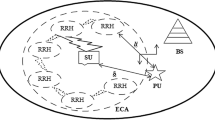Abstract
In Cognitive Radio Wireless Sensor Networks, the licensed spectrum bands are highly dynamic, and their status varies overtime. With the expansion of these networks, regarding the energy constraints and the fact that reallocation of the frequency spectrum is energy-consuming, the problem of controlling the behavior of secondary users in the allocation of the spectrum is of great importance. Providing a method to reduce the number of channel reallocation, which in turn results in reducing energy consumption in such a dynamical network is essential. In this paper, considering the energy constraints, an optimal method for allocating frequency spectrum resources is presented using game theory and Nash equilibrium. By analyzing the activity model of primary users on the frequency spectrum and selecting the appropriate spectrum using the Nash equilibrium, the method reaches the network to a stationary equilibrium point. In these conditions, in addition to reducing interference between primary and secondary users, the number of channel reallocations by cognitive radio users is reduced and thus reduces overall energy consumption in the network and increases its life span.











Similar content being viewed by others
Notes
Industrial, Scientific and Medical.
References
Akan, O., Karli, O., & Ergul, O. (2009). Cognitive radio sensor networks. IEEE Network, 23(4), 34–40.
Wang, B., Wu, Y., & Liu, K. J. R. (2010). Game theory for cognitive radio networks: An overview. Computer Networks, 54(14), 2537–2561.
Liang, Y.-C. (2020). Dynamic spectrum management: From cognitive radio to blockchain and artificial intelligence. New York: Springer.
Nie, N., & Comaniciu, C. (2006). Adaptive channel allocation spectrum etiquette for cognitive radio networks. Mobile Networks and Applications, 11(6), 779–797.
Zeng, B., Zhang, C., Hu, P., & Wang, S. (2017). Spectrum sharing based on a bertrand game in cognitive radio sensor networks. Sensors (Basel, Switzerland), 17(1), 101. https://doi.org/10.3390/s17010101.
Shyleshchandra Gudihatti, K. N., Roopa, M. S., Tanuja, R., Manjula, S. H., & Venugopal, K. R. (2020). Energy aware resource allocation and complexity reduction approach for cognitive radio networks using game theory. Physical Communication, 42, 10115.
Salim, S., & Moh, S. (2016). An energy-efficient game-theory-based spectrum decision scheme for cognitive radio sensor networks. Sensors (Basel, Switzerland), 16(7), 1009. https://doi.org/10.3390/s16071009.
Chiwewe, T. M., & Hancke, G. P. (2018). Fast convergence cooperative dynamic spectrum access for cognitive radio networks. IEEE Transactions on Industrial Informatics, 14(8), 3386–3394.
Rai, P., Ghose, M. K., & Sarma, H. K. D. (2020). A game theory-based framework for reliable and energy-efficient data delivery in cognitive radio wireless sensor network. In H. Sarma, B. Bhuyan, S. Borah, & N. Dutta (Eds.), Trends in communication, cloud, and big data. Lecture notes in networks and systems (Vol. 99). New York: Springer.
Sumithra Sofia, D., & Shirly Edward, A. (2020). Auction based game theory in cognitive radio networks for dynamic spectrum allocation. Computers and Electrical Engineering, 86, 106734.
Nie, N., Comaniciu, N., & Agrawal, C. (2006). A game theoretic approach to interference management in cognitive networks. Wireless Communications Springer, 143(5), 199–219.
Hao, H., Jie, C., Shoufeng, D., Shaoqian, L. (2008).Game theoretic analysis of joint channel selection and power allocation in cognitive radio networks. Cognitive Radio Oriented Wireless Networks and Communications 2008 3rd International Conference, 1–5.
Canales, M., Ramon Gallego, J., Ciria, R. (2011) .Distributed channel allocation and power control in cognitive radio networks using game theory. IEEE Conference on Vehicular Technology, 1–5.
Wu, C., Wang, Y., Yin, Z. (2018). Energy-efficiency opportunistic spectrum allocation in cognitive wireless sensor network. Eurasip Journal on Wireless Communications & Networking, 13.
Gmira, S., Kobbane, A., & Ben-Othman, J. (2018). A new energy efficiency/spectrum efficiency model for cooperative cognitive radio network. Mobile Networks and Applications, 23, 1436. https://doi.org/10.1007/s11036-018-1078-z.
Cesana, M., Cuomo, F., & Ekici, E. (2011). Routing in cognitive radio networks: Challenges and solutions. Ad Hoc Networks, 9(3), 228–248.
Tizvar, R., Abbaspour, M., & Dehghani, M. (2014). CR-CEA: A collision- and energy-aware routing method for cognitive radio wireless sensor networks. Wireless Networks, 20, 2037–2052.
Kamruzzaman, S., Kim, E., Jeong, D. G., & Jeon, W. S. (2012). Energy-aware routing protocol for cognitive radio ad hoc networks. IET Communications, 6(14), 2159–2168.
Li, Z., Chang, B., Wang, S., Liu, A., Zeng, F., & Luo, G. (2018). Dynamic compressive wide-band spectrum sensing based on channel energy reconstruction in cognitive internet of things. IEEE Transactions on Industrial Informatics, 14(6), 2598–2607. https://doi.org/10.1109/TII.2018.2797096.
Qiao, Yu., Jin, Z., Yao, K., & Ma, T. (2018). An energy-efficient cooperative spectrum sensing scheme based on d-s theory in cognitive radio sensor networks. ACM, Article, 58, 6. https://doi.org/10.1145/3164541.3164597.
Monderer, D., & Shapley, L. S. (1996). Potential games. Games and Economic Behavior, 14(1), 124–143.
Canberk, B., Akyildiz, I., & Oktug, S. (2011). Primary user activity modeling using first-difference filter clustering and correlation in cognitive radio networks. ACM/IEEE Transactions on Networking, 19(1), 170–183.
Lee, W. Y., & Akyildiz, I. (2008). Optimal spectrum sensing framework for cognitive radio networks. IEEE Transactions Wireless Communications, 7(10), 3845–3857.
Chen, Y., Zhao, Q., & Swami, A. (2008). Joint design and separation principle for opportunistic spectrum access in the presence of sensing errors. IEEE Transaction of Information Theory, 54(5), 2053–2071.
Tang, W., Shakir, M. Z., Imran, M. A., Tafazolli, R., & Alouini, M. S. (2012). Throughput analysis for cognitive radio networks with multiple primary users and imperfect spectrum sensing. IET Communications, 6(17), 2787–2795.
Ross, Sh. (2010). A first course in probability. New Jersey: Upper Saddle River.
Author information
Authors and Affiliations
Corresponding author
Additional information
Publisher's Note
Springer Nature remains neutral with regard to jurisdictional claims in published maps and institutional affiliations.
Rights and permissions
About this article
Cite this article
Sedighi, H., Abbaspour, M. Optimal Spectrum Allocation Based on Primary User Activity Model in Cognitive Radio Wireless Sensor Networks. Wireless Pers Commun 118, 195–216 (2021). https://doi.org/10.1007/s11277-020-08009-3
Accepted:
Published:
Issue Date:
DOI: https://doi.org/10.1007/s11277-020-08009-3




